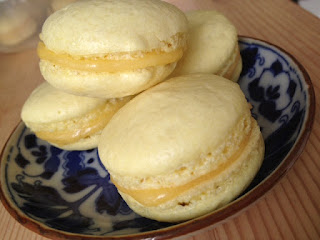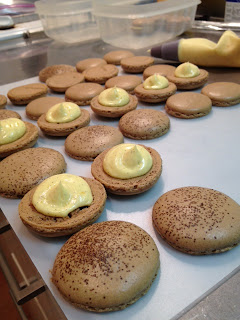The main thing that had me worried was the humidity in Tokyo, as I have often read that meringue in any form is difficult to make on a humid or a rainy day (some articles say to not even run the tap in the kitchen!). The good thing about making macaron in Tokyo though is that the almond powder sold here is very fine, dry and mild in flavour and it works a treat.
After sifting through various options I found a recipe and method that appealed to me - Stella Parks' macaron recipe on the BraveTart site. I particularly liked the no-nonsense myth-busting approach she uses, and can report that in the following 3 attempts I was able to produce something approximating a macaron in a diddy oven in my tiny and humid Tokyo kitchen:
 |
| Getting better! Cointreau coffee macaron with French buttercream filling |
The first batch I tried were chocolate macarons filled with dark chocolate Cointreau ganache. Hmm..
Ganache on anything is going to taste great, and as a first attempt these weren’t too bad... They tasted like posh brownies, rich and chewy. But there were no real feet, and many of the tops of the shells cracked in the oven, some were also difficult to separate from the parchment.. All of this points to the batter being over-mixed and therefore too wet.
After you have made a good stiff meringue, the mixing in of the dry ingredients (called the macaronage) is what seems to be the most important stage.
This is something you either have to try a couple of times for yourself, or maybe be guided in person, as written descriptions and photos are difficult to interpret. Reading the BraveTart website’s instructions to press down on the batter while folding - as macaronage is about deflating the meringue - I think I was a little over-zealous on my first, chocolate macaron attempt. I guess we're looking to deflate the meringue to some degree, but it will help to go slow, and to do the lava test as pictured in the coffee macaron batter below. Lift the spatula and the batter should be fluid enough to drop in a ribbon which, after resting atop the batter in the bowl for a few seconds (first pic), starts to merge back into it (second pic, about 15 seconds later).
It’s easy to forget to do this test, but more than counting strokes of the spatula this really will be your best guide to whether the batter has become just wet enough so that your tear-drop shapes will sink back into the piped blobs, but not so wet that they will flatten out too much, have trouble drying out and crack on top.
The second batch were macaron filled with left over lemon curd I had in my freezer.
The buttery lemon curd was a beautiful flavour match for the simple almond macaron shell. The main problem with this batch was that in trying to avoid the over-wettness of my first batch, the macaron shell batter was under mixed. Under-mixing resulted in a fluffy cloud-like rounded shape and an unfortunate hollowness to the shell. The lemon curd was a little bit drippy and difficult to pipe, and next time I’ll be braver with my application of colouring for the shell. There were some feet to be spied however, which made up for some of the faults.
The third and best batch so far were Cointreau-coffee macaron: coffee macaron shells with a Cointreau-spiked French buttercream filling.
These were my own invention, yay! My Nana and Granddad introduced me to Cointreau coffee as an after-dinner treat 15 or so years ago, and now it’s our special thing whenever I’m back in the UK and we go for a meal together. Cointreau coffee is like an Irish coffee, with the cream floating on top but made with the orange-flavoured liquer instead of whisky.
This is the first time that the texture of the macaron shell was just right – with some body to the bite you taste more of the almonds, and there is more there for the filling to infuse with further layers of flavour after a day or so in an air-tight box in the fridge. Since my tiny oven can only take about 9 shells at a time I had the opportunity to discover the difference made by the length of time the shells rest before baking. The shells left the longest had the best feet by far. The key thing here is probably not so much the length of time, but the dryness of the surface rested batter – (depending on the humidity and temperature it might take more or less time to get to the desired stage). The shells that went in for the last few batches were practically firm on top they were so dry, and in my kitchen (Tokyo, late August humidity, about 27 degrees centigrade) that was well over an hour. My gut feeling is that with the dry tops there is nowhere left for the steam and moisture of the enclosed batter to go but out the bottom, creating the feet in the process. Hurrah!
I doubt that I would actually sell macarons in the shop even if I get really good at them – there are so many real, French macaron specialist shops in Tokyo that it seems impractical, unless my flavours are interesting. It would be more interesting maybe to encourage others to try through workshops and macaron making parties. They really do feel like an achievement to make, are customizable once you've got the basics, and are a real pleasure to eat.
If you're inspired to have a go yourself, here's the link to my favourite macaron base recipe again. The coffee shells were made by adding 2 teaspoons of instant espresso powder and a teaspoon of cocoa powder to the dry ingredients of that basic recipe, and the Cointreau filling was made by adding about 4 tablespoons of Cointreau and some finely grated orange zest to about a third of a batch of faux French buttercream. The sprinkles on top of the shells were some of the coffee powder passed through a sieve over the top of the drying shells.












Bravo, the French would say for making such wonderful macarons as it is very difficult. They look great! N
ReplyDeleteDifficult, but not impossible! Try, try! Matcha and white chocolate ganache? :)
ReplyDelete